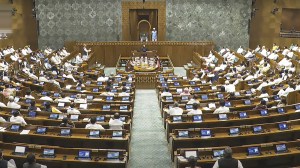Kamathipura revamp: Landowners to get 500 sq ft flats
For plots exceeding 200 square metres, an additional 500 square feet of housing will be provided for every additional 50 square metres of land area.
 Kamathipura, situated in the heart of South Mumbai, boasts a unique history spanning 200 years. (Express photo)
Kamathipura, situated in the heart of South Mumbai, boasts a unique history spanning 200 years. (Express photo)The state government Tuesday announced the compensation plan for landowners as part of the redevelopment of Kamathipura’s dilapidated cess and non-cess buildings.
According to a notification issued by the government, landowners with parcels ranging from 50 square feet to 200 square feet will receive up to four housing units of 500 square feet.
For plots exceeding 200 square metres, an additional 500 square feet of housing will be provided for every additional 50 square metres of land area.
This decision was made by the high-power committee formed by the state government, supervised by the Secretary of the Housing Department.
Kamathipura, situated in the heart of South Mumbai, boasts a unique history spanning 200 years. The area was originally settled by Telugu-speaking migrant labourers from Andhra Pradesh due to which the area came to be known as Kamathi, meaning “working labour.”
Later, the place also became infamous as redlight area of the city.
Meanwhile, the Maharashtra Housing and Area Development Authority (MHADA) has been designated as the Special Planning Authority (SPA) and appointed as the nodal agency for the Kamathipura redevelopment project.
The project covers 27.59 acres, encompassing lanes 1 to 15, with a total of 943 cessed buildings housing 8,238 tenants. These buildings are over 100 years old. There are also 349 non-cessed buildings, 14 religious structures, two schools, and four reserved plots within the area.
Additionally, 11 other buildings have already been redeveloped by MHADA.
Of the 943 cessed buildings, 180 have been demolished down to the ground floor due to their dilapidated condition, with residents relocated to transit camps.
The Kamathipura land is narrow, making individual building redevelopment impractical.
Therefore, MHADA has been tasked with conducting the redevelopment under the cluster redevelopment policy, in which several buildings will be redeveloped together.












